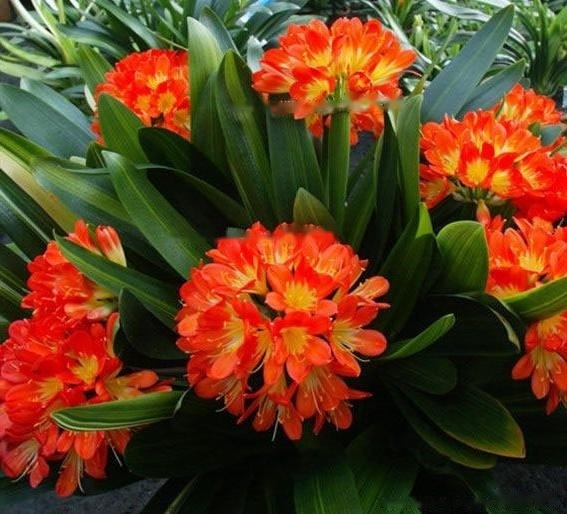
Chinese name: Clivia
Latin name: Clivia miniata
Aliases: Clivia, Daya , Sword Leaf Lycoris, Damnoli
Genus: Clivia
English Name: Bush lily
Status: Changchun City Flower
1. Morphology of Clivia
The root of Clivia is fibrous, milky white and very thick. The roots are thick and fleshy. The base of the leaves that persisted at the base of the stem of Clivia expanded and hugged each other into a pseudobulb shape. The leaves are stacked in two rows from the shortened stem at the root, neatly arranged, broad and band-shaped, rounded at the top, hard and thick in texture, glossy and veined. The basal leaves are thick, sword-like, leathery, dark green, shiny, band-shaped, 30-50 cm long, up to 85 cm long, 3-5 cm wide, attenuate at the lower part, alternately arranged, and entire.
2. Habits of Clivia
Clivia is native to the tropical regions of southern Africa and grows under the tree, so it is afraid of heat and cold, prefers semi-shady and humid Environment, fear of strong direct sunlight, the best growth temperature is between 18-28 ℃, below 10 ℃, above 30 ℃, growth is inhibited. Clivia likes a ventilated environment, likes deep, fertile and loose soil, and is suitable for growing in loose and fertile slightly acidic organic soil. Clivia is a famous greenhouse flower, suitable for indoor cultivation. Clivia normally blooms once a year, usually with more than a dozen leaves. If the indoor temperature is suitable, it can bloom before and after the Spring Festival. Clivia, known as the flower of wealth, generally blooms once a year when it grows up, rarely blooms twice a year, and rarely blooms three times.
3. Planting of Clivia
2-3 days after perianth dehiscence, when the flower bud is mature and the stigma has mucus secretion, it is the time for pollination. When pollinating, use a new brush to pick up the pollen from the stamens and gently vibrate on the stigma of the pistil. In order to increase the seed setting rate, pollination can be performed once between 9-10 am and 2-3 pm, and the seeds can mature after about 8-9 months. When the peel gradually changes from green to black and purple, the ear can be cut off, and the seeds are peeled off after 10-20 days. Before sowing, soak the seeds in warm water at 30-35°C for 20-30 minutes, then take them out and let them dry for 1-2 hours (if you can soak them in 10% sodium phosphate solution for 20-30 minutes at this time, take them out and wash them before placing them in the air. Soak it in clear water for 10-15 hours, it is better), then it can be sown into the culture soil. After sowing, the flowerpot is placed in an environment with room temperature of 20-25 ℃ and humidity of about 90%, and the radicle will germinate in about 1-2 weeks. Before sowing propagation, first prepare the culture soil. There are many materials available for making culture soil, but one that is easier to obtain is to use loose soil with sufficient humus taken from the surface of the forest, mixed with 1/3 of clean fine sand.
Guess you like it
Hyacinth | Fortune Tree | >FishXingcao|Yew|Lemon| Lucky Bamboo|Egg fruit
Chrysanthemum| Clivia| Lotus| | forget me not | aloe vera | saffron | sunflower | lily of the valley | betel nut |
![[Dog Training 5] The training method of pet dog dining etiquette](/static/img/12192/12192_1.jpg)




